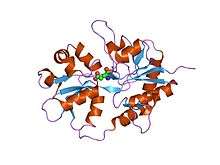Ionotropic glutamate receptor
Ionotropic glutamate receptors (iGluRs) are ligand-gated ion channels that are activated by the neurotransmitter glutamate.[1] They mediate the majority of excitatory synaptic transmission throughout the central nervous system and are key players in synaptic plasticity, which is important for learning and memory. iGluRs have been divided into four subtypes on the basis of their ligand binding properties (pharmacology) and sequence similarity: AMPA receptors, kainate receptors, NMDA receptors and delta receptors (see below).[2]
| Lig_chan | |||||||||
|---|---|---|---|---|---|---|---|---|---|
 x-ray structure of the glur6 ligand binding core (s1s2a) in complex with glutamate at 1.65 a resolution | |||||||||
| Identifiers | |||||||||
| Symbol | Lig_chan | ||||||||
| Pfam | PF00060 | ||||||||
| Pfam clan | CL0030 | ||||||||
| InterPro | IPR001320 | ||||||||
| SCOPe | 1gr2 / SUPFAM | ||||||||
| TCDB | 1.A.10 | ||||||||
| OPM superfamily | 177 | ||||||||
| OPM protein | 3kg2 | ||||||||
| |||||||||
AMPA receptors are the main charge carriers during basal transmission, permitting influx of sodium ions to depolarise the postsynaptic membrane. NMDA receptors are blocked by magnesium ions and therefore only permit ion flux following prior depolarisation. This enables them to act as coincidence detectors for synaptic plasticity. Calcium influx through NMDA receptors leads to persistent modifications in the strength of synaptic transmission.[3][4]
iGluRs are tetramers (they are formed of four subunits). All subunits have a shared architecture with four domain layers: two extracellular clamshell domains called the N-terminal domain (NTD) and ligand-binding domain (LBD; which binds glutamate), the transmembrane domain (TMD) that forms the ion channel, and an intracellular C-terminal domain (CTD).[5]
Human proteins/genes encoding iGluR subunits
AMPA receptors: GluA1/GRIA1; GluA2/GRIA2; GluA3/GRIA3; GluA4/GRIA4;
delta receptors: GluD1/GRID1; GluD2/GRID2;
kainate receptors: GluK1/GRIK1; GluK2/GRIK2; GluK3/GRIK3; GluK4/GRIK4; GluK5/GRIK5;
NMDA receptors: GluN1/GRIN1; GluN2A/GRIN2A; GluN2B/GRIN2B; GluN2C/GRIN2C; GluN2D/GRIN2D; GluN3A/GRIN3A; GluN3B/GRIN3B;
References
- Traynelis SF, Wollmuth LP, McBain CJ, Menniti FS, Vance KM, Ogden KK, Hansen KB, Yuan H, Myers SJ, Dingledine R (September 2010). "Glutamate receptor ion channels: structure, regulation, and function". Pharmacol. Rev. 62 (3): 405–496. doi:10.1124/pr.109.002451. PMC 2964903. PMID 20716669.
- Collingridge GL, Olsen RW, Peters J, Spedding M (January 2009). "A nomenclature for ligand-gated ion channels". Neuropharmacology. 56 (1): 2–5. doi:10.1016/j.neuropharm.2008.06.063. PMC 2847504. PMID 18655795.
- Bliss TV, Collingridge GL (January 1993). "A synaptic model of memory: long-term potentiation in the hippocampus". Nature. 361 (6407): 31–39. doi:10.1038/361031a0. PMID 8421494.
- Citri A, Malenka RC (January 2008). "Synaptic plasticity: multiple forms, functions, and mechanisms". Neuropsychopharmacology. 33 (1): 18–41. doi:10.1038/sj.npp.1301559. PMID 17728696.
- Traynelis SF, Wollmuth LP, McBain CJ, Menniti FS, Vance KM, Ogden KK, Hansen KB, Yuan H, Myers SJ, Dingledine R (September 2010). "Glutamate receptor ion channels: structure, regulation, and function". Pharmacol. Rev. 62 (3): 405–496. doi:10.1124/pr.109.002451. PMC 2964903. PMID 20716669.